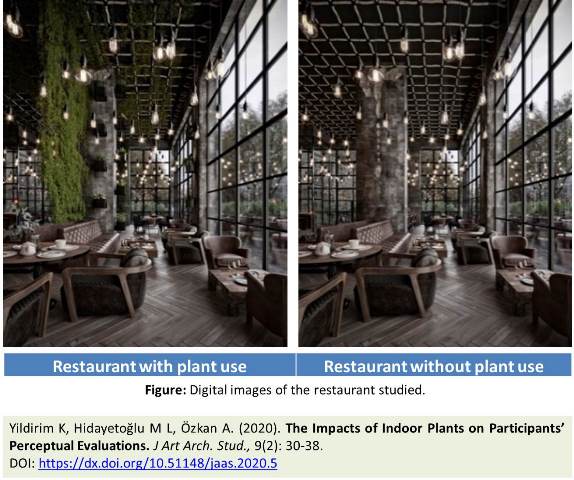Most read content
Previous issue | Next issue | Archive
![]() Volume 9 (2); December 15, 2020 [Booklet]
Volume 9 (2); December 15, 2020 [Booklet]
The Impacts of Indoor Plants on Participants’ Perceptual Evaluations
Yildirim K, Hidayetoğlu M L, Özkan A.
J. Art Arch. Stud., 9(2): 30-38, 2020; pii:S238315532000005-9
DOI: https://dx.doi.org/10.51148/jaas.2020.5
ABSTRACT
In this research, it was aimed to define the impacts of plants on the perceptual evaluation of participants in a restaurant environment. As an experimental setting, two different digital images of the modelled restaurant were used. Semantic differentiation scale was used to evaluate the environmental factors for this research environment, and the results obtained from 335 participants were evaluated with the SPSS program. The results showed that the atmospheric attributes of the restaurant with using plants had a more positive impact on the perceptual evaluations of the participants than the restaurant without plants. In addition, male and young (26-35) participants perceive more positively than female and middle-aged (36-55) participants. The use of indoor plants in key retail stores such as restaurants can increase preferability and positively impact customers' perceptual evaluations, feelings, and thoughts within first impressions.
Keywords: Indoor plants, Restaurant, Customer, Perceptual evaluations, Design
[Full text-PDF] [HTML] [ePub] [XML] [Crossref Metadata] [Export from ePrints]
Understanding the concepts of Islamic wisdom and its effects on the formation of mosque architecture
Sattari Sarbangholi S and Pakdelfard MR.
J. Art Arch. Stud., 9(2): 39-44, 2020; pii:S238315532000006-9
DOI: https://dx.doi.org/10.51148/jaas.2020.6
ABSTRACT
Man, who is an innate being, needs a place to communicate with his Creator, which has celestial and spiritual characteristics that make it possible to experience the ascension of the soul and its connection to the eternal universe. Among the divine religions, Islam has given the most importance to the social aspect of worship, the place that has made this serious matter possible is of great importance. Therefore, mosques have a high status, they are the beating heart of Islamic cities and the most important and best places should be provided for mosques. The first step taken by the Prophet Muhammad (PBUH) after the formation of his government in Medina was the construction of the Quba Mosque, which became the original model of all mosques. In addition to the Islamic spirit, this mosque also had an Islamic identity because it had an Islamic body. The religion of Islam reincarnated the Islamic spirit into the body of Iranian structures upon its arrival in Iran. It is a fact that the newborn replaced the spirit of buildings and inelegance (Zoroastrian temples and shrines). That is, the Islamic spirit flowed in the Iranian vessel. Many mosques that were not built on fire temples and shrines retained the same Iranian body with Islamic spirit, so the Iranian identity was represented in the form of mosques.
Keywords: Islamic Art Wisdom, Mosque, Islam, Iranian Architecture
[Full text-PDF] [HTML] [ePub] [XML] [Crossref Metadata] [Export from ePrints]
Previous issue | Next issue | Archive




